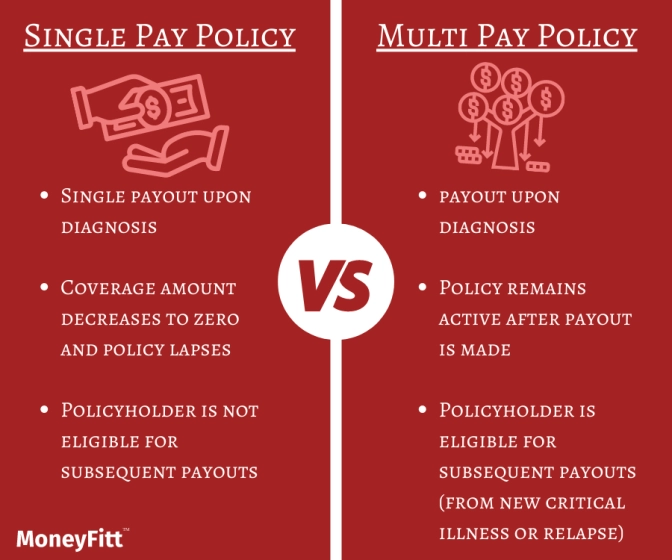Critical Illness Insurance: Why You Need It Even with Health Insurance
A critical feature of your financial armour
- Critical illness (CI) insurance pays out upon diagnosis of a preset list of major illnesses.
- This form of insurance serves as a form of income replacement. It supports your lifestyle and financial needs for the period you are out of work while recovering from your illness.
- It is particularly important to consider your critical illness coverage if you have bills and financial responsibilities that are dependent on your income.
The majority of conversations about insurance coverage revolve around health insurance (i.e. hospital plans) and traditional life insurance (payouts in the event of death). However, many people do not often stop to consider what cover they have in place if they contract a life-threatening illness after leaving the hospital and should it not take their life.
They are more common than we may realise:
- In the UK, 14% of critical illness claims are made before the age of 40
- In Singapore, CI claims among adults aged 31 to 40 are growing
There is an age-old saying regarding insurance: “When you don’t need it, that’s exactly when you buy it; because by the time you need it, it’s too late”. This saying applies to critical illness cover above all, as you become uninsurable upon diagnosis, regardless of your coverage status beforehand.
What is Critical Illness Insurance?
Critical illness (CI) coverage - referred to as ‘crisis cover’, ‘dread disease’, or ‘trauma cover’ in some regions - is a form of insurance that pays out upon diagnosis of a preset list of major illnesses, such as stroke, kidney failure, cancer etc. It is often divided into ‘early CI’ and ‘late CI’ coverage, which payout in the event of early-stage & late-stage diagnoses, respectively.
Due to its importance and necessity, it is most commonly sold as a ‘rider’ - a supplementary attachment - to a basic life insurance policy. An example in practice is the following:
Mike purchases a Term Life Insurance Policy with Company X. His insurance agent has demonstrated to Mike that he lacks sufficient coverage in the event of a critical illness, so Mike agrees to attach a basic critical illness rider to his policy.
His coverage amounts to the following.
Sum Assured in the event of:
Basic Policy (Death & Terminal Illness): $1,000,000
Total & Permanent Disability (TPD) Rider: $1,000,000
Critical Illness (Basic) Rider: $250,000
There are two main forms in which this coverage is packaged; Single Pay and Multi Pay.

A Single Pay policy will payout once upon diagnosis, and the policy will subsequently lapse as there is no remaining coverage amount.
A Multi Pay policy (relatively new and modern type of CI plan) will payout upon diagnosis. Still, the policy will remain active even after a payout is made. The policyholder will be eligible for subsequent payouts upon the diagnosis of either a brand new critical illness or the relapse of the prior critical illness. This is a massive benefit considering this is the only way a person can remain insured after having been through a critical illness. As a result, this policy style is often considerably more expensive than a single payout policy.
Why Is Critical Illness Insurance Important?
There are countless articles detailing the “why” of CI coverage. We will keep this segment to the point and address it in the context of the most commonly asked CI-related question:
If I Already Have a Hospital Plan, Why Do I Need Critical Illness Coverage?
Well, while a hospital plan (basic health insurance) covers the otherwise daunting hospital bills incurred when a major illness is contracted, it covers the hospital bill only and on a reimbursement basis. This is true of any health insurance worldwide.
The fact of the matter is, if you contract a critical illness, there are expenses that will extend far beyond hospital and surgery bills. You will likely lose the ability to perform your job while in recovery, but your bills and financial obligations are, unfortunately, not going to stop! Here is a new perspective for you:
Critical Illness Insurance Is Meant as Your Source of Income Replacement!
When a person comes down with a critical illness - let’s say cancer - you are most certainly not going back to work anytime soon. You will have all of the rehabilitation therapy that goes with remission and the exorbitant costs that go along with the latter. Combining this with your now sudden loss of an income stream, the average person will find themself in a severe financial deficit.
Countless studies worldwide have shown the average recovery period for a major critical illness to be between 3 to 5 years. That is several years where you will need a form of protection that keeps you financially afloat.
To show this in practice using our previous example:
Previously, Mike’s agent suggested the following coverage amounts:
Basic Policy (Death & Terminal Illness): $1,000,000
Total & Permanent Disability (TPD) Rider: $1,000,000
Critical Illness (Basic) Rider: $250,000
Mike now questions his agent’s choice to set his CI Coverage at $250,000. His agent explains his basis of calculation:
Mike stated he earns $5,000 per month. To allow for three years of income replacement, as well as some leeway for added rehabilitation costs and unforeseen medical expenditure*, the result is:
Annual Income: $5,000 x 12 = $60,000
3 Years’ Income: $180,000
Including leeway for rehabilitation costs: $250,000
* The Singapore Life Insurance Association (LIA) recommends that as a rule of thumb, you need a coverage amount of 3.9x your annual pay. In this case, this would be $234,000 ($60,000 x 3.9), rounded up to $250,000 to provide some extra coverage and peace of mind.
(Recommendations differ a little in other countries, but this is a useful general guide.)
So for Mike, should he contract a critical illness during his policy term, in addition to his health insurance covering the weight of a likely enormous hospital bill, he will receive a one-time payout of $250,000 from his chosen insurance company.
This money has absolutely nothing to do with a person’s hospital bill. It will be for them to use at their discretion, to pay for their bills, fund their children’s education or whatever else they deem fit.

TL;DR: Health insurance covers your hospital bills only. Critical illness insurance replaces your income while you are in remission and unfit for work, as well as any post-hospitalisation rehabilitation costs.
When Should I Be Covered for Critical Illness?
The answer is simple; if you are a working adult with bills to pay, you should make sure you are covered.
Interestingly enough, a common school of thought as of 2021 is that critical illness cover should come even before traditional life insurance, in terms of priority. The line of reasoning is that critical illness coverage, as established in the ‘why’ section above, is meant to cover the loss of income of a working adult.
But what does life insurance cover? When you really think about it, what is the death benefit of a life insurance policy meant to cover? Simple. Financial liabilities & obligations. Specifically, leaving these liabilities for your loved ones to have to pay off after you pass on. Examples include an outstanding mortgage on a house, outstanding loans on vehicles, tertiary education tuition fees etc.
These liabilities tend to come later in life; usually when one is in your late twenties or early thirties and beyond.
However, when do we actually join the workforce as young adults? Usually in our early twenties.
Assuming you are the average 25-year-old, it is highly unlikely you have any major financial obligations amounting to tens of thousands of dollars to meet. You do, however, have monthly living expenses such as food & transport. Perhaps you are paying rent and living on your own.
You pay for everything described above with your employment income; income which you will lose if you, unfortunately, contract a critical illness. Ergo it is actually important to cover yourself against a critical illness as soon as you start working, perhaps before you are even covered against death, as you will not be leaving huge debts or liabilities behind should you pass on later in life.
You can buy critical illness coverage either on a standalone basis or as a rider on a whole or term life policy. (If income is limited, you could do the latter on a relatively small term policy.) We strongly suggest that you seek the advice of an insurance professional for the right insurance coverage for your personal needs and stage in life.
Conclusion
Having a major health crisis can potentially be as taxing on our wallets as our bodies. Don’t let it be both. A comprehensive critical illness plan can be the last line of defence standing between you and financial catastrophe. Not only for yourself but also for those who would step in to help you in your time of need, such as your parents, perhaps out of their retirement savings, or siblings and friends.
Of course, do not just buy the first plan you see. Your needs depend on your income, life stage, pre-existing medical conditions and more. If this article has convinced you of the necessity of CI coverage but you have no idea where to start, it is a good idea to consult a trusted advisor or agent about getting yourself covered, before it’s too late.
CRITICAL ILLNESS INSURANCE. COMPLETED. ✅
Sources:
